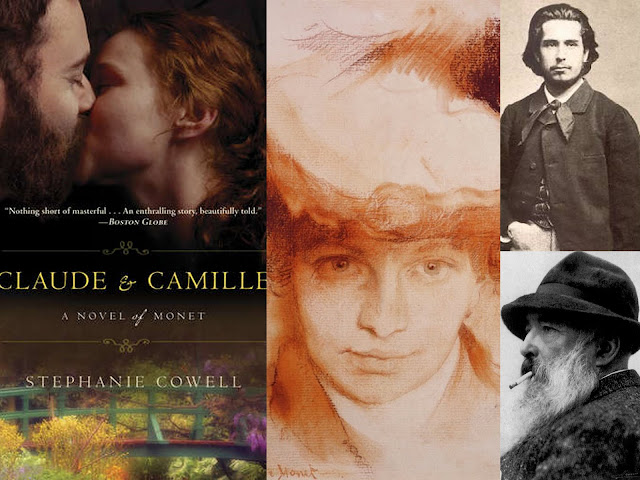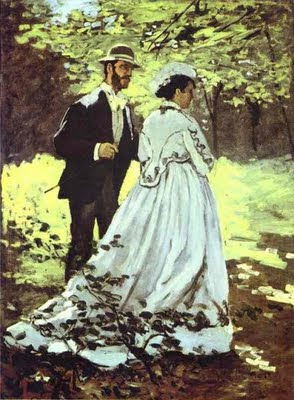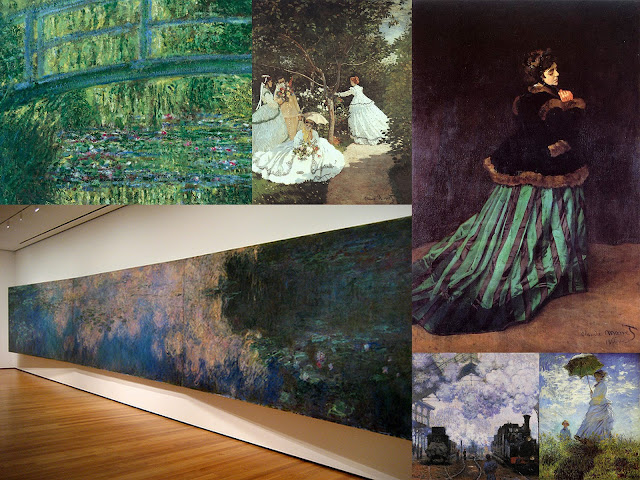The paintings of Claude Monet are some of the most recognizable and popular in the world. They tend to have a very strong effect on viewers and make you feel romantic, relaxed, and happy. How lucky are we that Stephanie Cowell chose to write about Monet’s life and the love of his life, his muse, Camille?
My book club recently read Stephanie Cowell’s Claude and Camille. We all loved it so much that I think we could have talked about it for hours. It was so easy to get lost in Monet’s world…romance, art, gardens, beauty…
As I was reading, I couldn’t help think of what Mikhail Baryshnikov said about being in the arts, “People of art should never get married and have children, because it’s a selfish experience.” This is so true! No matter the art: music, dance, painting…all art consumes the personal life and self of the artist.
Camille’s support system included Claude’s friends. One of his closest friends, Frédéric Bazille, completed an interesting triangle.The three were harmoniously together quite often and deeply cared for one another.
The struggle of these previously starving but now famous artists: Renoir, Bazille, and Pissaro, Cezanne, Manet is now known to us all. They were bohemian Impressionistic nomads who attempted to get their art into the annual State salon at the Palais de L’Industrie. The tight bunch of friends lived on beans, wine, coffee, and bread, and would take turns sleeping on the floor.
From one painting Monet entered in the salon (Impression, Sunrise), a new art movement began and Monet emerged as the leader of the whole group (Frédéric Bazille, Paul Cézanne, Edgar Degas, Edouard Manet, Berthe Morisot, Camille Pissarro, Auguste Renoir and Alfred Sisley) due to a hostile critic who coined the term “Impressionists.”
Looking back on his life at sixty-years old Monet said, “I was born in a circle entirely given over to commerce, and where all professed a contemptuous distain for the arts.”
Camille grew up in a bourgeois upper class family and left behind her well off fiancé and family when she ran away with Monet. Once she met Monet, she knew she wanted to rebel. She threw away her life of privilege to be with him. Camille became Claude’s true inspiration, his muse.
It’s no wonder Camille’s family was not pleased with their daughter’s decision to run off with Claude because they knew he could not support her. Monet had a different idea of what work was. His father (and Camille’s) could not convince him to take on a “real” job.
I read that he hated school and always wanted to be outside; loving the open-air, he had an obsession with sea cliffs. He grew up in the sleepy sea town of Le Havre were his dad sold supplies to fisherman.
Monet brought sunshine into his art work. More than any of his colleagues, he loved to be outside and find inspiration for his paintings. He was fascinated with how sunlight made colors look different at different times of the day.
Monet once said, “I have so much fire in me and so many plans. I always want the impossible. Take clear water with grass waving at the bottom. It’s wonderful to look at, but to try to paint it is enough to make one insane.” It seemed part of Camille’s job as his muse was to keep Monet from going insane.
As family life became more important to him with the birth of their first son Jean, Monet’s art took on an emotional richness, and a depth; at the soul of his painting was Camille.
Camille had a hard time finding herself. She tried her hand at writing and acting, realizing it wasn’t for her she became depressed.
When my book club discussed Cowell’s book, one of the hot topics was if we thought Claude was selfish. I believe it was unanimous that we all thought he was selfish and should have tried supporting his family in another way while they were literally starving! As my friend Linda said, “He puts his pants on just like everyone else.”
We agreed that he was dedicated to his art to the point of selfish irresponsibility but his paintings make up in beauty what he could not give to his loved ones.
Monet was prepared to make any sacrifice and have his family undergo discomfort for the sake of his art. For Monet, art came first and family second. Monet truly loved Camille but he had a difficult time balancing his two loves (art and family). Painting was how Monet dealt with reality and relationships.
Camille had such a profound effect on Monet’s career. She was as mysterious as the water lilies that he strove to capture on canvas. She was complex and kept a lot of secrets. I think she was very much a free-spirit and loved Claude. He painted her for years, even in death. He felt as long as she was on his canvas, she was with him; she haunted him in life and death.
Cowell beautifully expresses how much Monet loved Camille, “My love for you is deep, deep inside myself like something below the water. Only with my brush when I can paint again will I express it.”
Camille’s sister Annette blamed Claude for Camille’s death. Reading Cowell’s book you get a better understanding of Monet’s thinking…”Annette, I wish I were a better man than I am; I could wish it a thousand times,” he replied. “All I know is that Minou loved me and I loved her. You wanted a certain life for her, but she had to choose her own. She chose me and my work. I’m not separate from my work. She was very clear in what she chose, and she didn’t choose to die. I’ll never believe that. And if I ever betrayed her, I’m sorry a thousand times.”
Monet’s second love, Alice Hoschedé was a cultured woman from a very comfortable middle-class background. Alice took a huge risk (a lot like Camille) when she went to live with Monet with her six children who was then a penniless artist. It was actually Camille’s idea to invite Alice and her children to live with them.
Another hot topic to our book club discussion was that we wondered if Camille knew Claude cared for Alice when she invited Alice and her six children to live with them. Oh to have a time machine that could take you back to find out details!
Early on with Camille, he hardly made any money, not being able to pay rent and owing everybody. Monet relied almost entirely on his paintings to keep his family alive. Sadly, Camille never experienced the good life he eventually had in Giverny with Alice and their combined eight children.
I visited Claude Monet’s house in Giverny when I was seventeen; I remember the vivid colors and the calm and happy feeling of the painter’s beautiful garden and pink house. It was full of bourgeois character and charm. The color palette and décor is something I knew I wanted in my home, especially the yellow dining room because it’s such a cheery color.
Claude Monet is so identified with his home in Giverny. This book mostly focuses on a time before Giverny. He spent forty-three years there and created most of his great work outside in his garden.
Monet painted in many different settings throughout his life: Algeria, (painting the African sun when he was in the military), England, Holland, and the countryside and seasides of France. During his entire career, he always loved to be outside.
Cowell changed the way I look at Monet’s paintings. She made me more observant to the emotions in his art. I imagine if you read Claude and Camille you will feel the same way.
In the end, Monet lost both wife’s (Camille and Alice), his eyesight, and his beloved stepdaughter. Sometimes through tragedy comes the creation of great beauty. Monet’s breathtakingly beautiful work gives him (and Camille) immortality. Cowell painted the images of the characters in the readers mind through her words and truly brought Monet’s art to life.








